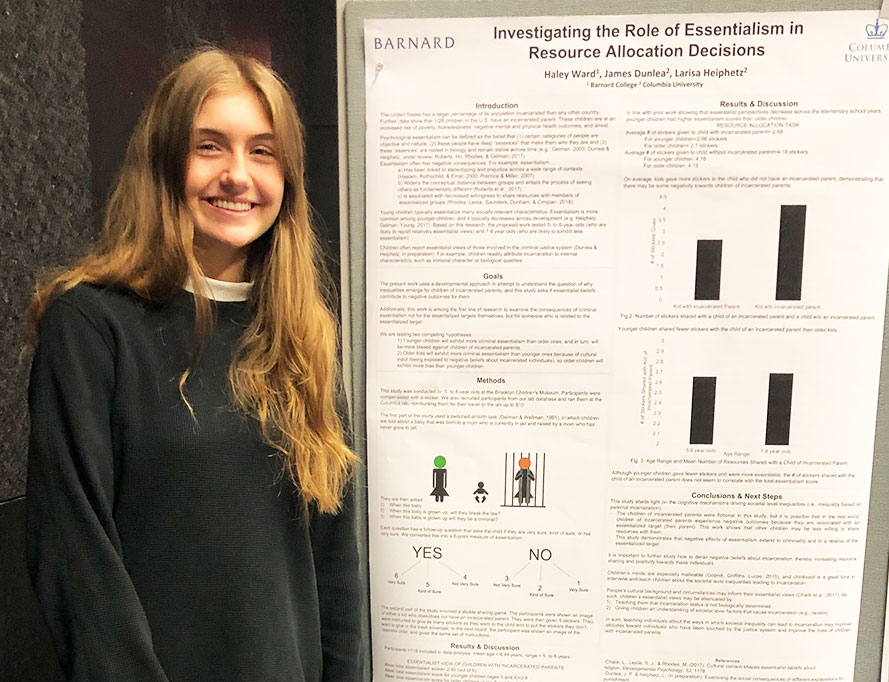As undergraduate research assistants, Nikki Kaiser ’19 and Haley Ward ’21 (above) worked separately under assistant professor of psychology Michael G. Wheaton to learn about anxiety disorders and how best to treat them.
Kaiser helped conduct a study that focuses on how two different factors — intolerance of uncertainty and anxiety sensitivity — might contribute to adult separation anxiety disorder (ASAD), a relatively new, understudied diagnosis describing how adults can experience strong symptoms of anxiety when they are apart from an important figure in their life. With Wheaton’s support, Kaiser attended the Annual Association for Behavioral Cognitive Therapy Conference in the fall, where she presented a poster on their study. After graduation, she worked as a research assistant for Dr. Kristin Vickers at Ryerson University in Toronto and started a new research position in New York City in October 2021. In the future, Kaiser hopes to pursue a Ph.D. in clinical psychology.
Ward contributed to a 2021 study with Wheaton that explored the COVID-19 pandemic’s effects on people living with obsessive-compulsive disorder (OCD). Alongside Alana Silber ’21, she carried out the literature review, assisted with the qualitative analysis, and helped write portions of an academic paper. Ward hopes the research will better educate the public and aid in the creation of improved treatments. After Barnard, she aims to continue studying OCD in graduate school, earn a Ph.D., and eventually become a professor and researcher on the disorder. Ward currently works at a digital mental health company, where she uses qualitative research techniques to assess the effectiveness of an app that is designed to enhance mental health, physical health, and well-being across the continuum of care.
To learn more about the research that Kaiser and Ward conducted at Barnard, read each of their Q&A’s below.
Nikki Kaiser ’19
How would you describe this research and what you discovered to a lay audience?
Adults who have ASAD often have strong symptoms of anxiety when being separated from an attachment figure, such as a parent or a spouse. For a long time, people thought that separation anxiety only happened in children, but real fears of separation are common in adults too. Therefore, a lot of foundational research needs to be done.
Our study focused on two different factors that might contribute to ASAD: intolerance of uncertainty and anxiety sensitivity. Simply put, intolerance of uncertainty is when a person feels strong negative emotions about the unknown, and anxiety sensitivity is when a person fears that there may be negative consequences from anxiety symptoms, such as “If my heart races really fast, I might have a heart attack.” Both intolerance of uncertainty and anxiety sensitivity contribute to the development and maintenance of a lot of anxiety disorders. This study sought to see if those factors contribute to ASAD as well. We had nearly 800 participants fill out various questionnaires, and our results showed that both factors contribute to symptoms.
What was your role?
I was involved in the study from start to finish and given the opportunity to complete segments independently as well as collaboratively. I conducted the literature review prior to beginning the project, which is standard for all research endeavors [because] it’s important to see what information is out there, what has already been studied, and what’s left to be discovered. After we finalized the hypotheses and collected the data, it was fascinating to review the results and have our research questions answered. [Professor] Wheaton gave me the exciting opportunity to help write the manuscript and assist in the final edits. As our paper is now published, it is an amazing feeling to [know] that I was able to contribute to important disseminated research.
Why is it important to study this topic?
When dealing with clinical diagnoses, it’s incredibly important to understand what factors might contribute to the development of a disorder or help maintain a disorder. By understanding these characteristics, researchers can develop treatments that target underlying causes. Therefore, if anxiety sensitivity is found to be a strong contributing factor to ASAD, treatments for ASAD might focus on reducing anxiety sensitivity in a patient, thereby reducing overall symptoms of ASAD.
How has this experience been useful to you since graduating?
Working on this research has not only taught me important skills and given me invaluable experience, but it has opened doors for me since graduation. I am currently in the process of moving cities and applying to new jobs, and this study has been a discussed topic in each interview I’ve had. Not many recent graduates get the opportunity to assist in writing and publishing a paper, so it has certainly been a point of interest for future employers. It’s wonderful to have an experience that I am passionate about that I can discuss deeply, given my direct involvement.
Where do you see this research going in the future?
I hope that this study can inform other researchers, be replicated in a clinical population, and ultimately be beneficial to treatment development. Additionally, separation anxiety disorder is often misdiagnosed in adults and is [likely] a lot more prominent in the population than current numbers suggest. Unfortunately, because it has only recently gained recognition, research on the topic is scarce and much is left to be understood about the disorder. I hope that publishing this study not only brings awareness but instigates other researchers to begin conducting more studies on ASAD.
Not many recent graduates get the opportunity to assist in writing and publishing a paper, so it has certainly been a point of interest for future employers.
Haley Ward ’21
How would you describe the research from your recent journal article to a lay audience?
For this study, we utilized qualitative and quantitative methods to evaluate how COVID-19 was affecting individuals with OCD during the early days of the pandemic in the United States. We found that individuals with OCD had heightened concerns about COVID-19, and the pandemic exacerbated symptoms and complicated treatment for many. Although the majority of respondents reported that their symptoms had worsened, there was substantial variability in the responses among the community — many experienced what they perceived to be slight worsening, while fewer experienced substantial worsening or no change. The pandemic was more likely to impact people with certain types of OCD. People who had obsessions about germs and responsibility for harm were more likely to experience negative effects from the pandemic.
What was your role?
I was primarily involved with conducting a literature review, analyzing the qualitative data we collected via thematic analysis, and writing up the manuscript for publication, along with another Barnard student, Alana Silber ’21.
Why is it important to study this topic?
OCD is a debilitating condition, associated with substantial impairment, poor quality of life, high levels of distress, and interpersonal problems. One important aspect of our paper is that it’s a demonstration of how heterogeneous OCD really is. Many people associate OCD with cleanliness or order, and there are a lot of different ways OCD can manifest. Obsessions can include intrusive thoughts about safety, directly harming loved ones, or sexuality, and compulsions may include excessive checking, praying, or engaging in mental rituals.
This study also highlighted the importance of treatment accessibility and the potential utility of online treatment. The transition to teletherapy is not just important because it helps us get through COVID-19, but it can help us target communities that have had a difficult time accessing in-person services, such as those in rural areas [or] with physical disabilities preventing them from [traveling] easily, so more research on perceptions of telehealth in the OCD community is needed.
Where do you see this research going in the future?
Many researchers are continuing to study the OCD community during COVID-19. One question a lot of us still have is how symptoms waxed and waned throughout the pandemic. Were symptoms worse at the beginning of the pandemic, in the middle, or during reopening and vaccine distribution, and why? With the number of individuals with OCD reporting disruptions to their treatment regimen, I also hope that this research inspires others to more closely examine how to respond to future pandemics/disasters and how to make treatment more accessible in general.


